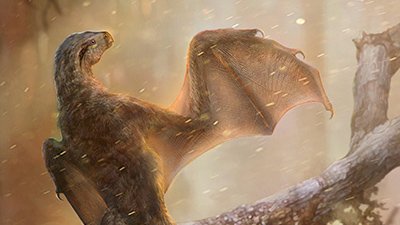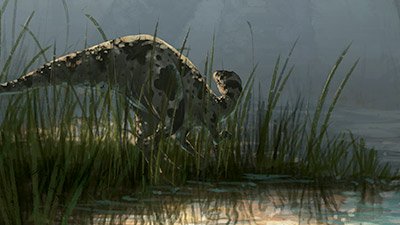Dino Babies
“The sound of little prehistoric feet tells the story” but not necessarily the story some think!
News Source
- Independent Online: “The Pitter-patter of Dinosaur Feet”
Visions of dinosaur domesticity danced across headlines after a report of the “oldest known dinosaurian nesting site” got imaginations churning. “The imprint of those baby feet, made 190 million years ago” in South Africa’s Golden Gate National Park are revealing dinosaur “child-rearing practices,” suggesting the Massospondylus “was a caring and doting parent.” Fossils of this six-meter-long sauropod are common in South Africa, although no adults (or young dinosaurs either) were found at this road cut excavation site.
According to researcher Adam Yates, “Some [footprints] are so tiny, they had to have been hatchlings. Others are twice that size, but not the size of adults.” (The feet of the unhatched dinosaurs were about 7 mm long; the larger tracks were 15 mm long. No adult tracks were found.)1 “Hatchlings were doubling in size before moving away from the nesting area,” Yates says. “The babies were toothless, so they were probably being provisioned by their parents, maybe being fed regurgitated food.”
Researchers have identified collections of tightly packed eggs at the Rooidraai site—as many as 34 together—in several discrete layers of sedimentary rock piled up about 2 meters thick along a road cut 25 meters long. They suspect these sauropods returned each season to the nesting site. Only rapid burial could preserve the eggs and embryos without “disintegration, predation, and trampling during subsequent breeding seasons,”2 the researchers write, so they propose, “[u]nusually intense or out-of-season flooding events . . . led to burial and preservation of egg clutches before hatching.”3
Unusually intense or out-of-season flooding events . . . led to burial and preservation of egg clutches before hatching.
Because the Rooidraai site consists of an Early Jurassic layer in the geologic column, the authors believe the “nesting site” is “100 million years older than previous known [nesting] sites.” Most dinosaur egg fossils have been found in Late Cretaceous rocks. Co-author David Evans says, “This amazing series of 190 million year old nests gives us the first detailed look at dinosaur reproduction early in their evolutionary history, and documents the antiquity of nesting strategies that are only known much later in the dinosaur record.”4 “What’s so important about it,” he explains, “is that it gives us a very detailed window into the evolution of reproduction in dinosaurs right at the base of their family tree, just as they were starting to take over the world.”5 The researchers believe their evidence of dinosaur parental care, gregarious colonial nesting behavior, and seasonal return to nesting sites suggests these nesting behaviors evolved early in dinosaur history.
At the risk of disturbing this touching scene of maternal devotion, we should examine several key points. First of all, while eggs were in tightly packed clutches, the researchers specified there was no “definitive . . . evidence of nest construction.”6 Furthermore, the tracks offered as evidence for dino babies remaining near their nests were not found where the eggs were found. There were no dinosaur tracks at all “within the nest-bearing succession”7 “Numerous tiny prints are scattered”8 elsewhere on broken slabs along with fossil evidence of swimming fish.
The 10-meter thick road cut (containing the 2-meter thick bed with the eggs) consists of many layers of fine sediment with “small desiccation cracks, wave ripples, and wrinkle marks”9 indicative of “repeated [at least 20] low-energy flooding events and ponding, usually followed by desiccation,”10 according to the authors. However, ripples and wrinkle marks are made by moving water, and cracks do not necessarily imply desiccation. Cracks are equally consistent with rapid water drainage from recently deposited, rapidly buried sediment. The weight of subsequent sediment deposits would have squeezed water out of the underlying layers of sediment containing the eggs and tracks, causing those layers to eventually dry, shrink, and crack.
The researchers admit, “[t]he precise time interval separating each nest level is difficult to assess.”11 Thus, even though the researchers believe dinosaurs returned seasonally, the layers could have been deposited within hours or days of each other, with some layers burying clutches of eggs. There is no evidence the dino-mommies built any nests at all. We don’t even know whether they dug out some sort of hole, but given the tendency of evolutionary paleontologists to explain bird behavior as an evolutionary derivative from dinosaurs, we need to avoid thinking of these so-called “nests” as some sort of bird-like construction.
The researchers also suggest the tender image of dinosaur mothers arranging eggs after laying them. But the last time we saw the arrangement of small fossils being offered as evidence another creature had intentionally arranged them, we were reporting on the ridicule certain members of the scientific community received when they suggested a giant squid played with its food. The dinosaurs may have simply laid their eggs all at once, as other reptiles do. The image of dino-siblings toddling around the nest doesn’t seem supportable either. There appears to have been sufficient calcium carbonate (a natural cement, now concentrated in nodules)12 originally dispersed through the in the water-borne sediment to preserve tracks, yet no tracks were preserved near the nests. Furthermore, no dino-toddlers were buried with the eggs and embryos. The dino-daycare seems uninhabited.
Meanwhile, dino babies were leaving their tracks elsewhere to be preserved by sudden burial in sediment borne by surging floodwater carrying fish. Since no actual hatchlings or tracks were found near the eggs, the relationship of the 15 mm tracks’ owners to the parent dinosaurs can only be a matter for speculation. The researchers described the eggshells as being extremely thin.13 Some living reptiles retain their eggs until the shells thin completely away and give birth to live young. Little is known about dinosaur reproduction, but based on the various reproductive strategies seen in living reptiles, it is possible these sauropods laid their eggs when they were nearly ready to hatch. Perhaps the mother dinosaurs retained eggs in their bodies as long as possible during turbulent conditions, allowing longer for development. But whether or not these dinosaurs would have normally cared for their young simply cannot be determined from these fossils.
The biblical account of the global Flood about 4,300 years ago explains these findings. Conventional dating of this Jurassic layer as 190 million years old is based on a number of unverifiable assumptions. The layers of the geological column are predominantly a record of the order of burial during the Flood, not millions of years of evolution. Larger animals would have been able to flee the rising water for a time. The Flood did not instantaneously cover the whole earth but according to Genesis chapter 7 rose over a period of weeks. Thus as oceanic water carrying sediments surged repeatedly over the land, dinosaurs carrying eggs would likely have hastened to deposit them on any briefly exposed land after the water ebbed and temporarily receded. Each surge of water would have deposited a fresh load of sediment, burying the latest batches of eggs as well as fresh tracks made by very young dinosaurs. The evidence from Rooidraai is therefore fully consistent with biblical history. Truly, as the researchers say, “unusually intense, out-of-season flooding events” rapidly buried these eggs. An apt description of the rising waters of the biblical Flood!
Further Reading
- Group of Infant Dinosaurs Found In Fossilized Nest
- Doesn’t the Order of Fossils in the Rock Record Favor Long Ages?
- Order in the Fossil Record
- Geologic Column
- The Fossil Record
- Unlocking the Geologic Record
- Radiometric Dating: Back to Basics
- Radiometric Dating: Making Sense of the Patterns
For More Information: Get Answers
Remember, if you see a news story that might merit some attention, let us know about it! (Note: if the story originates from the Associated Press, FOX News, MSNBC, the New York Times, or another major national media outlet, we will most likely have already heard about it.) And thanks to all of our readers who have submitted great news tips to us. If you didn’t catch all the latest News to Know, why not take a look to see what you’ve missed?
(Please note that links will take you directly to the source. Answers in Genesis is not responsible for content on the websites to which we refer. For more information, please see our Privacy Policy.)
Footnotes
- Reisz, R. et al., “Oldest Known Dinosaurian Nesting Site and Reproductive Biology of the Early Jurassic Sauropodomorph Massospondylus,” Proceedings of the National Academy of Sciences 109, no. 7 (February 14, 2012): 2428–2433, http://www.pnas.org/content/109/7/2428.
- Ibid.
- Ibid.
- University of the Witwatersrand, “Ancient Dinosaur Nursery—The Oldest Nesting Site Ever Found,” EurekAlert!, January 23, 2012, http://www.eurekalert.org/pub_releases/2012-01/uotw-adn012312.php.
- Kaleigh Rogers, “Team Led by ROM Scientist Unearths Oldest Dinosaur Nursery,” January 23, 2012, http://www.theglobeandmail.com/news/national/toronto/team-led-by-rom-scientist-unearths-oldest-dinosaur-nursery/article2312512.
- Reisz et al., “Oldest Known Dinosaurian Nesting Site . . . ”
- Ibid.
- Ibid.
- Ibid.
- Ibid.
- Ibid.
- Ibid.
- Ibid.
Recommended Resources

Answers in Genesis is an apologetics ministry, dedicated to helping Christians defend their faith and proclaim the good news of Jesus Christ.
- Customer Service 800.778.3390
- Available Monday–Friday | 9 AM–5 PM ET
- © 2025 Answers in Genesis







